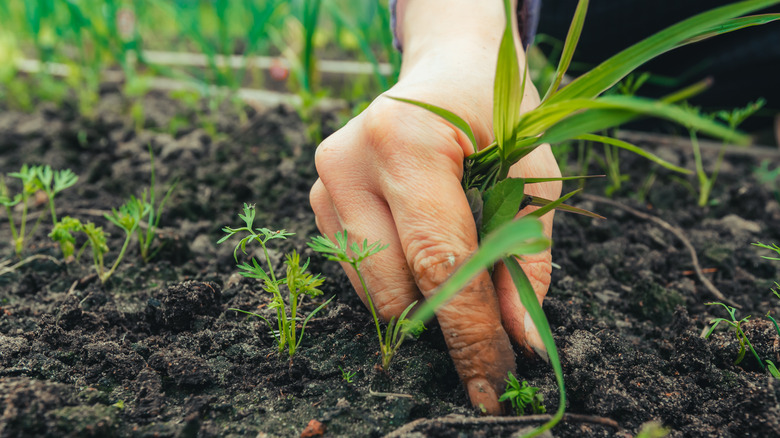The Key To Keeping Weeds At Bay Is In How You Water Your Garden
If only there were a way to permanently get rid of weeds in your garden and cross it off your list of garden chores forever. But weeds are just plants like any other, and where there is sunlight, water, and soil, they'll grow. On the other hand, by depriving them of one of those essentials, you can prevent weeds from growing as abundantly and save yourself some effort. In this case, that essential is water.
Rather than watering your garden from above with a hose or watering can, try a technique called subsurface watering. It involves delivering water directly to the deeper layers of soil where the roots are, bypassing the top layers where most weed seeds are. Without water, these seeds are prevented from germinating, so you'll notice less weed growth overall. Subsurface watering also has the added benefit of reducing water waste. Less water is lost to runoff and evaporation, and the soil retains more room to absorb rainfall. Plants are also less likely to be overwatered with this method. There are several different ways to incorporate subsurface watering into your own DIY garden watering system.
Four subsurface watering methods to try
The most well-known form of subsurface watering is called subsurface drip irrigation. It's similar to regular drip irrigation, except that the lines are buried about 16 to 20 inches deep in the soil. This method allows you to cover a large area of land and is typically used on large-scale farms rather than gardens. It's not the most practical for home use because it's expensive, requires special equipment to install, and is difficult to alter after installation, but it is an option.
Another option is a practice used in core gardening, which involves digging a trench about 8 to 10 inches deep in the center of your garden and packing it full of organic material to act as a "sponge." Thoroughly soak the core before doing your spring planting. Then, it will serve as a reservoir of moisture, releasing water into the surrounding soil as needed and allowing you to water much more sparingly. Alternatively, you can buy or make a set of ollas, traditional unglazed terracotta pots that serve as underground water reservoirs. These pots need to be refilled once or twice a week.
Lastly, you can opt to try irrigation stakes. These are most often designed for trees and shrubs with deep roots, but some brands sell shallower stakes for smaller garden plants, such as the Root Quencher Spike and the Deep Drip Stake. These stakes connect to a water source such as a hose and feature adjustable chambers to direct water below the surface. Research shows that watering at least 5 inches below the surface is effective at reducing weeds.
Another essential weed prevention technique
Although subsurface watering prevents you from unintentionally watering weeds, rainfall can still soak them and cause them to germinate. For extra protection against weeds, cut out another one of the essentials they need to thrive: sunlight. There are a number of barriers you can use to physically block the weeds from getting enough sun to thrive, including cardboard, newspaper, landscaping fabric, or even plastic tarp. Each barrier has its pros and cons. For example, cardboard is breathable, but may disintegrate in a few months depending on the conditions. Landscaping fabric isn't biodegradable, but it's permeable enough to allow water through and some gardeners may prefer how long it lasts.
Whichever barrier you choose, make sure you properly secure it in place and weigh it down with mulch or gravel. Maintain the barrier over time by keeping it clear of debris and covering any unwanted holes. Keep in mind that if you cover the barrier with mulch, it will eventually decompose and form a layer of soil that is just as conducive to weed growth as the original soil underneath. You have to regularly refresh your barrier to keep it weed-free.


